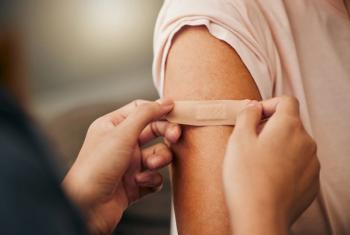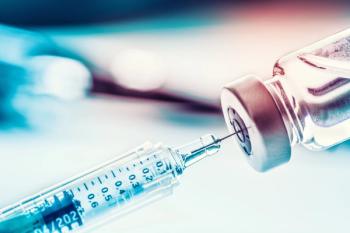
- Consultant for Pediatricians Vol 4 No 10
- Volume 4
- Issue 10
Photoclinic: Adverse Reaction to MMR Immunization
This 12-month-old girl presented with a diffuse rash that was first noticed by the child's day-care provider a day earlier. A fever (temperature of 39.4°C [103°F]) subsequently developed.
This 12-month-old girl presented with a diffuse rash that was first noticed by the child's day-care provider a day earlier. A fever (temperature of 39.4°C [103°F]) subsequently developed. There was no history of upper respiratory infection; however, the child had completed a 10-day course of amoxicillin for otitis media 2 days earlier. She had no sick contacts and had good urinary output and a healthy appetite. The child appeared nontoxic; results of the physical examination were unremarkable except for the fever and the nonpruritic, erythematous maculopapular exanthem on her face, trunk, back, and upper and lower extremities. The rash did not seem to bother the child.
Further questioning revealed that the patient had received her measles-mumps-rubella (MMR) immunization injection 12 days earlier. Results from a complete blood cell count, blood cultures, and urinalysis and cultures were all normal.
Erika G. Gonzalez, MD, of Biloxi, Miss, diagnosed an adverse reaction to the MMR vaccine. The vaccine is a live-attenuated virus that is administered subcutaneously. The American Academy of Pediatrics recommends that all children receive 2 doses of the combined MMR vaccine after their first birthday, unless there is a contraindication.1 The first dose is usually given at 12 to 15 months of age and is followed by a second dose at age 4 to 6 years. If a child receives his or her first MMR dose before age 12 months, 2 additional doses are still required after the child's first birthday. The second dose of MMR vaccine may be given before age 4 to 6 years but must be separated from the first dose by at least 4 weeks.2
For most persons, the vaccine causes few or no problems. The most common reactions include pain, swelling, and redness at the injection site. A high fever (temperature of 39.4°C [103°F]) develops in up to 10% of children, and a diffuse maculopapular rash develops in about 5% of vaccinees about 6 to 12 days after the injection.2 The fever and rash last about 2 to 3 days, and the child is not contagious during this period. No treatment is necessary. This child's fever subsided later the same evening; the rash resolved fully 2 days later.
Less common adverse reactions to the MMR vaccine include seizures, anaphylaxis (most often caused by the neomycin and gelatin preservatives in the vaccine), transient thrombocytopenia, temporary arthritis, mild lymphadenopathy and, in very rare instances, encephalitis.2 Mild adverse reactions do not contraindicate subsequent administration of the MMR vaccine. Absolute contraindications include pregnancy; immunodeficiency; immunosuppressive therapy; or an anaphylactic reaction to a previous dose of MMR, neomycin, or gelatin. Children with HIV infection who are not severely immunocompromised can receive the MMR vaccine according to current schedule recommendations.2 Children and other household contacts of pregnant women, as well as household contacts of immunocompromised persons, should also be vaccinated according to the recommended schedule.
Appropriate administration of the MMR vaccine confers immunity in 95% to 98% of recipients after the first dose and in 99% of recipients after the second dose.1 Adverse reactions can be ameliorated with properly dosed acetaminophen at the time of vaccination or shortly afterward. The side effects are generally mild and predictable and, when they occur, are outweighed by the benefits associated with MMR immunity.
References:
REFERENCES:
1.American Academy of Pediatrics. Committee on Infectious Disease. Age for routine administration of the second dose of measles-mumps-rubella vaccine.
Pediatrics.
1998;101:129-132.
2.American Academy of Pediatrics. Measles. In: Pickering LK, ed.
Red Book: 2003 Report of the Committee on Infectious Disease.
26th ed. Elk Grove Village, Ill: American Academy of Pediatrics; 2003: 419-429.
Articles in this issue
about 20 years ago
Carbon Monoxide Poisoning: Clues to Unmasking the Great Masqueraderabout 20 years ago
Pediatrics Update: Amblyopia Therapy Is for Older Children Tooabout 20 years ago
Tinea Faciei and Tinea Versicolorabout 20 years ago
Photoclinic: Hooked Fingerabout 20 years ago
What’s Wrong With This Picture? Child With Fever and Persistent Coughabout 20 years ago
Photoclinic: Plexiform Neurofibromaabout 20 years ago
Pediatrics Update: Avian Flu: Why All the Squawk?about 20 years ago
Photoclinic: Perianal Streptococcal Dermatitisabout 20 years ago
Photoclinic: Bohn NodulesNewsletter
Access practical, evidence-based guidance to support better care for our youngest patients. Join our email list for the latest clinical updates.









